на
главную
| |
|
Fishing |
525
|
| Boats |
534
|
| Hunting
of Sea-Mammals |
541
|
| Hunting
of Land-Game |
553
|
| War |
558
|
VII. Fishing, Hunting, and War
528
JOCHELSON, THE KORYAK.
sinkers, stones are employed,
while the floats are made of wood or birch-bark.
A long seal-skin thong, the use of which has been borrowed by the Russian
settlers from the Koryak, serves to set the net. At each end of the seine
this thong extends about fifteen metres. One end is left in the hands of
the
"shoremen," — that is, of the fishermen who remain on the
bank of the river, —
while the other end is kept in the boat in which the whole seine is
placed.
As the boat glides gradually away from the bank to the middle of the
river,
the seine is cast. Then the boat describes a semicircle against the
current;
then it turns slowly about towards the bank, the net having first been
pursed.
During this process the "shoremen", following the current, which carries along
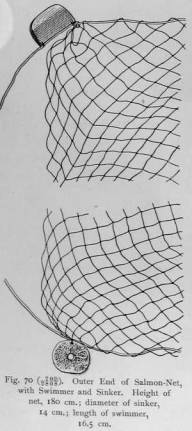
|
both the net and the boat, must
move
along the bank down the river. When the
seine has been pursed, the oarsmen h ul
the boat ashore, and, with the help of the
shoremen, gradually pull it in by both
ends, and throw the fish into the boat after
having stunned them with a club. The
boats used by the Russians on the Gishiga
River are of the Yukaghir type, and are
made of poplar-wood.
The
Maritime Koryak have not adop-
ted the seine-fishery of the Russian settlers.
They use
nets, — the same kind as
the y
evidently employed before the arrival of
the
Russians, — tackle, hooks, harpoons,
and traps.
Fig.
70 Outer End of Salmon-Net,
with
Swimmer and Sinker. Height of
net,
180 cm.; diameter of sinker,
14
cm.; length of swimmer,
16.5
cm |
Nets
are made of nettle-fibre or sinew-thread. They are of the types of casting-
nets, hand-nets, or dip-nets. Casting-nets
for dog-salmon and humpback salmon (Fig.
70) are made of nettlethread. They are
from twelve to fourteen metres in length;
in width, from twenty-nine to thirty meshes,
the sides of the meshes measuring from
three to five centimetres. Disk-shaped sink-ers are made of whale-vertebrae, and flat
floats of drifted larch-wood are used. The
thong to which
the net is fastened is made of thong of the ringed-seal. The
net is pushed into the water by means of
a pole from twenty metres or more in length, (Plate xxvii, Fig. 2), made up of
several pieces scarfed together, the joints being held by a winding of
thong.
To push the net out, the end of the pole is placed in a loop in the thong,
by
530
JOCHELSON,
THE KORYAK.
purpose
three stakes are driven into the bed of the river, to two of which the front
sticks of the net are tied, so that the mouth of the double net is kept
wide open, while the point of the net is tied to the third stake. Through
the first
funnel-shaped bag the fish
is carried by the swift current
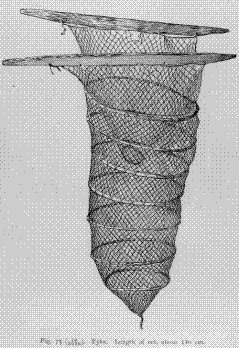 |
into
the second, closed bag,
from which it cannot
escape. The fish
is taken out by untying
the bottom of the
net, and then sha- king
it out.
Fig. 74 represents
a
hand-net on a frame. As shown in the illustration,
the net is strung
on a stout thong
which is attached
to the frame, being
held in place by
being tied to it through
a number of perforations.
The free farther
left-hand end of
the thong passes through
a perforation in
a cross-bar of the frame,
and it seems the
net is pursed by- letting
go of this string. In the illustration the specimen
is shown tied by strings to the
cross- bar. These, however, are
probably taken off
Fig.
73. Fyke. Length of net, about 110 cm.
|
when
the net is in use. Plate XXVII, Fig. 2
shows
how the Koryak, standing in
the water, hold the hand-net. The photograph from which it was made
was taken on the sea-shore, near the mouth of the Ovekova River. Just
before the tide begins to come in, the dog-salmon gather near the mouth of
the river, ready to enter with the tide, and in such numbers that large quantities
are caught even with hand-nets. During low tide the mouth of the
river dries up. Only shallow rivulets remain, through which the river- water
flows into
the sea.
A number of families
of the Taigonos Reindeer
53I
JOCHELSON,
THE KORYAK
Koryak
and nomadic Tungus fish at the mouth of the Ovekova River every summer.
The hand-net is netted of nettle-thread, and is called krivda
(кривда)
by
the Russians, and colpi'na by the Koryak
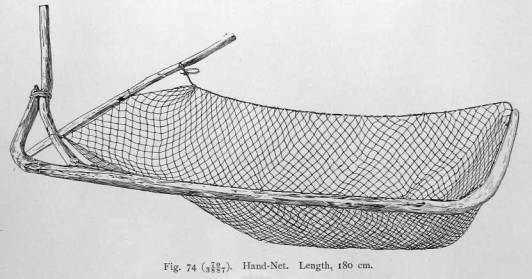
The Russianized Koryak at the mouth of the
Nayakhan River employ a
bag-shaped
hand-net, one
half of the opening of which
is tied at its ends to
|
a
pole. The fisherman,
standing
up to
his
knees
in water, drops the
net into the river,
while
holding the free
end
of the pole with
his
hands. The Koryak
make
a hand-net
of
reindeer-sinew
for the
purpose
of catching
tom-cod
in small rivers.
When
it is
in use,
one
fisherman stands in
the water and holds
the
net, while another
drives
the fish into it.
Fig.
75 represents
a
scoop-net for Salmo
socìalis and
herring.
|
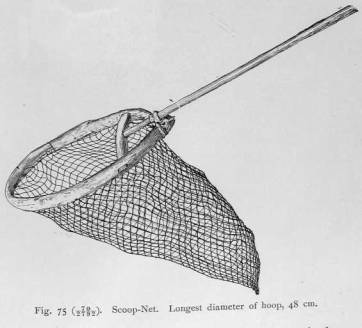 |
|
Fig. 75 Scoop-Net. Longgest diameter of
hoop, 48 cm. |
The fish are simply scooped up with it.
Salmo sociahs comes in such dense
532
JOCHELSON,
THE KORYAK.
masses,
that every
time the
net is
dipped into
the water
and hauled out again, it is full of fish. As stated before,
however, the run of Salmo socialis does not last more than about seven
days. In the years when herring enter
the mouths of Koryak rivers, that fish is also quite numerous, but it
does
not come in such masses as
Salmo socialis. In
Fig. 76,
a and
b represent
fishing-tackle for catching
torn-cod in
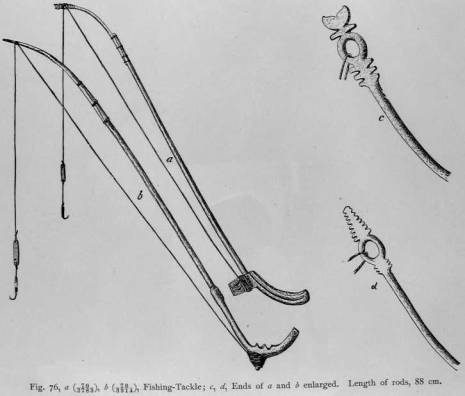
Fig.
76. Fishing- Tackle; c, d, Ends of a and b enlarged. Length of
rods, 88 cm.
winter through ice-holes in the
mouths of rivers and in bays: a was obtained
in the village Kuel; b, in
the village Itkana. The fishing-tackle consists of
a wooden rod, a wooden or bone handle, a curved tip prettily carved out
of
reindeer-antler, and a fish-line twisted of thread made of the sinew of
the
white whale. The fish-line with hook and sinker is passed through a hole-
made in the upper bone end of the rod (Fig. 76, c and d). The
other end
of the line is wound around the projection on the handle, and is paid out
as needed; and in this way the angler, without rising from his place or
moving the
fishing-rod, can pull
his line out from the
ice-hole, with
the fish
Jesup North Facific Expedition, Vol. VI.
Plate XXVIII.
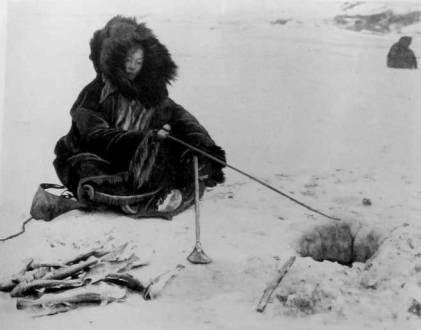
Fig.
i.
Woman Fishing.
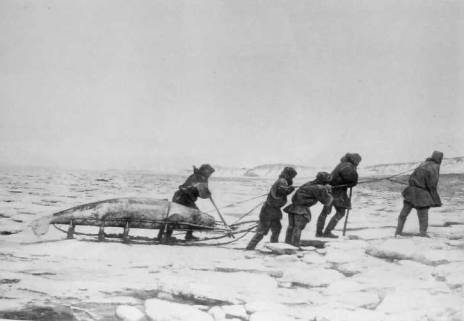
Fig.
2. Hunters
bringing in White Whale.
The
Koryak.
533
JOCHELSON,
THE KORYAK.
caught.1 The sinker is now made of lead,
and the hook of iron ; but in
olden
times the sinker was of stone, and the hook of bone. Plate XXVIII,
Fig.
1, represents a Koryak girl, muffled up in a winter overcoat, sitting
with
fishing-tackle on a bag spread out
by the ice-hole. Near by lie a pile
of
tom-cod, a club for stunning the fish, and a ladle or shovel for clearing
the
ice-hole from ice.
In Fig.
77 a,
is illustrated
such a
shovel made
of deer-antler,
and
fastened
to a
stick by means of
thongs. The
length of the handle enables

Fig.
77. Ice-Scoops, Length 94 cm., 103 cm.
the angler to clear the ice-hole without leaving
his position. Fig. 77 b, represents
a ladle made of the horn of a mountain-sheep, which is sometimes
used
instead of a shovel. The catch of tom-cod from under ice is particularly
abundant
in the mouths of rivers in the beginning of winter. Women, girls,
and
boys engage in angling. Thickly studded with ice-holes, and muffled
figures
sitting near them, the river presents an odd appearance. At Itkana,
in
the fall, men too engage in fishing tom-cod, which is then particularly
abundant in Itkana Bay.
Fig.
78 shows a tackle used for the salveline and grayling. The line
is
twisted of sinew-thread. Another hook used for flounder, cod, and sculpin,
has
a stone sinker and a bone barb.
Fig.
79 shows an iron hook (kiyi'ki) for dog-salmon. Its lower end is
tied
with a strip of skin to a long pole. When the sharp end of the hook
has
caught the fish, the hook slips off from the pole after the manner of a
harpoon,
and remains hanging on a long line, the end of which is shown in
the illustration. Such hooks are widely used by the Tungus, from whom I
believe
the Koryak have borrowed them. On Plate XXVI, Fig, 2, is
shown
a
boy with such a hook, on the seashore. A similar hook of smaller size is
used
by the Koryak for salveline. In olden times the Koryak employed
bone
hooks and barbed harpoons to catch fish. In excavating ancient under-
ground
houses I
found fragments of such implements.
The
Maritime Koryak
build hardly
any weirs
(ai'pai), nor do they set
1 A somewhat similar contrivance is
found in the fishing-tackle of the Alaskan Eskimo (cf. Nelson, p.
175).
534
OCHELSON, THE KORYAK.
traps made of willow. In the sea and in the lower
parts of rivers this
method
of fishing is impracticable, but in mountain-rivers traps and weirs are
employed
by the Reindeer Koryak.
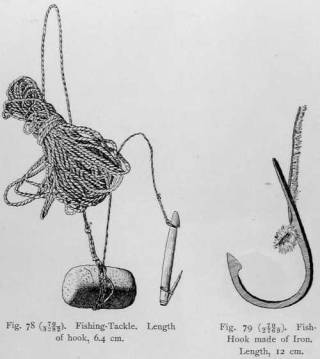
|
Boats.
—
Before entering
upon a description
of
the method of hunting
sea-mammals,
it will be
well
to describe the boats
employed by the Koryak,
as
they are indispensable
in sea-hunting.
Skin
Boats. —
The
skin
boat of the Koryak
(Russian,
baydara; Koryak,
ga'twaat or ne'lge
ga'twaat;
literally, "of
hide
a boat") is construc-
ted
after the type of the
Aleut,
Eskimo, and Chuk- chee
skin boat. A woo-den
frame, lashed toge-
ther
with thong and there-
fore possessing great
elasticity, is covered withseal or walrus
skin. The
Koryak skin
boat is
|
| Fig, 78. Fishing-Tackle.
Length of hook, 6.4 cm. Fig. 79. Fish-Hook made of Iron. Length,
12 cm |
distinguished
from the others by several peculiarities of form and construction
of
the frame. In
proportion to its length, it is very wide; and at both ends

of the frame, bows are tied to the rails of the
boat, giving both prow and
stern
a semi-circular shape (Fig. 80), while in the Chukchee and Eskimo
skin
boats the ends of the rails, converging at the prow and stern, are
joined
by cross-bars only.1
1 Compare
Bogoras, The Chukchee, Vol. VII of this series, p. 128; Nelson, Plate LXXIII,
Fig. 38.
535
JOCHELSON,
THE KORYAK.
The
keel or
central timber (cï'leq, "backbone"), shown
in a, is made of
a
single long
timber bent
upward in
the direction
of the prow,
after the
fashion
of a
sledge-runner. The
fore-end of the prow terminates in a
fork,
through
which the
harpoon-line is
passed when
the harpoon is hurled at a
sea-mammal.
Sometimes this fork, on
which a human face is carved
to serve
as
a protector for the boat, is
made of a separate piece of wood, and is tied
with
thongs to
the upturned fore-end of the
keel. At the
stern the central
timber
is turned
up at
an angle
(a'). Generally
the stern
post is
made
separately,
of the lower part of a tree and its root,
which join at a right or
obtuse
angle, according to the kind of tree selected. The bent stern post is
then
fastened to the central timber by means
of thongs, which pass
through
drilled
holes. The bottom of the skin boat
is formed by the flat part of the
central
timber and
the lateral
curved double
beams on either side (6), the
ends
of which are fastened to the central timber aft at the angle of the stern,
and
forward at
the place where the keel begins to curve upwards.
To the
flat
bottom of the frame belong also the cross-bars (c),
which are fastened by
thongs
passing through
holes in
the central
timber (a)
and the
two side-beams
(b).
The sides
of the boat
are formed,
in the first place, by
the ribs (d). The
mid-ribs passing from the curved side-beam (6) are shorter than the ribs which
issue immediately
from the central
timber (a) near the prow.
These
also
form a more obtuse
angle with the bottom than do the mid-ribs.
The
ribs
are fastened
with thongs to the curved lateral bottom
beams (b) of the
boat
on its inner side, and to the central timber and to the gunwales (e) on
the
outside. The wooden
frame is further strengthened by the rails (f), which
run
along under the gunwales, and are fastened to the inside of the ribs, and
the double longitudinal cleats (g), which
are fastened to the ribs both on the inside
and on the outside.
The outer cleat is of one
piece; while the
inner
one
consists of separate
pieces, and is not continuous.
They serve both to
strengthen
the frame
and as
steps to
avoid treading on the
skin covering
while
boarding the
boat, and
to prevent the
cargo from
pressing against it.
Both
forward and aft
a bow is attached to the
rails (f), which rests on
the
inner
side of the frame, against the upturned central timber.
Thwarts for the
oarsmen
(h) rest on the rails (f), and are tied with thongs to the gunwales (e). At
the prow
and stern semicircular
boards also rest on the rails (f).
They
are tied to the
bows of the gunwale.
At the stern this board
serves as a
seat
for the steersman, while that at the prow (2) is the seat of the harpooneer.
The
model represented in Fig. 80 has the
following measurements: —
Greatest width of front
board (i)
22.0 cm.
Greatest
width (19 cm. afc from the stem) .... 26.5
cm.
Width
at ithwart...............................................................................
26.3 cm.
Width
at 2d thwart..........................................................................
25.0 cm.
68—JESUP NORTH PACIFIC
EXPED., VOL.
VI. PART
2.
536
JOCHELSON, THE KORYAK.
Width
at thwart....................................................................
23.0 cm.
Width
at stern thwart..........................................................
21.0 cm.
Length from stern rib
(d')
to main rib (ä")..........
69.0
cm.
Greatest
width of bottom....................................................
14.0 cm
Height
from main beam
to thwart.................................
8.0 cm.
A boat in the village of Kuel that was considered
large, which I measured,
had
a length
of nine
metres, and a maximum width between the gunwales
of
two
metres and a half. The
maximum width was not in the middle,
but nearer
to the
stern. The
Koryak boats
of Penshina Bay are considerably
wider in proportion to
their length
than the Chukchee1 and Eskimo boats.
The
boat mentioned by me had thirty ribs on each side, approximately twenty-
five
centimetres apart. The
usual number of thwarts is four or five for eight
or ten oarsmen, — two oarsmen to each bench. Men as well as women row.
The
thwarts are mostly situated aft, leaving the forward part free.
The freight
is
placed in
the middle
of the boat, for which
purpose the thwarts are far
apart
at that
place. The
prow, where the ribs are fastened to the central
timber,
is somewhat
narrower than
the stern part, and
the prow is a little
higher
than the stern.
In Kamenskoye the prow
projects upward more (see
Part
I, Plate
vii, opp.
p. 80)
than in
the boats
on the Paren, where the
model
was made from which
Fig. 80
was drawn.
On
the coast of Bering Sea, boats are covered with walrus-hide; on the
coast
of Okhotsk Sea, owing to the absence of the walrus there, the boats
are
covered with skins of the thong-seal. The skin of the walrus is first split,
as
it is too thick. At present, even in Bering Sea, the practice of covering
boats
with the skins of thong-seals is spreading, largely owing to the disappear-
ance
of the walrus. The skins of the thong-seal are dressed and the hair
is
removed. The cover is sewed together with very close stitches. Before
being
drawn over the frame, it is soaked in the river or in the sea. Then
it
is pulled over the frame so that the edges extend upward over the gunwale.
Then
the edges are folded over the gunwale. No far from the edge a
number
of slits are made, through which stout thongs are passed by means of
which the cover is tied to the rails (f)- (see Figs. 81 and 82). After
the
cover has been put on, the boat is turned upside down and dried, so
that
the contracting cover presses the wooden frame tightly together. Then
the
seams are filled with fat, and the whole cover is greased with seal-oil, so
that
it may not get wet in the water, and the skin boat is launched into the
sea.
Fig. 81, drawn from a model, represents the side-view of a skin boat
with
cover on. The
oars have long rounded blades.
Instead of the rowlock,
1
The exact
measurements of the
length and
maximum width of the large Chukchee skin boat brought by
Mr. Bogoras are 11.5 metres and
1.5 metres respectively (cf. Bogoras, The Chukchee, Vol. VII of this
series, p. 127).
2 Compare the same process in Boas, Central Eskimo, Fig. 480, p. 528.
3 On the festival of the launching of the skin boat, see Part I, p.
79.
537
JOCHELSON,
THE KORYAK.
they have an ingenious device, which is also found
among the Central Eskimo.1
The
oar is placed in two crossing thong loops, which are attached to the
rails.
To prevent the oar from slipping in the loops, it has two wooden
projections
with notches, into which the loops are laid. One loop lies in the

upper, the other in the lower notch. The loops
are fastened to wooden
guards,
which cover the gunwale and protect the skin from the friction of
the
oars (Fig. 82).
Among the Eskimo the guards are made of bone.2

The
Koryak have not as yet adopted the rudder, but steer with an oar.
The
blade of the stern oar is shorter but wider than the blades of the ordinary
oars.
Usually one half of the blade of the stern oar is made of bone of whale, which is sewed to the
wooden half by
means of small thongs.
The
Koryak are better sailors than the Kamchadal, but still they cannot
be
called real seamen. They do not undertake long voyages, and rarely sail
far
away from the shores. In summer they often cross Penshina Bay (the
inhabitants
of Kamenskoye sometimes sail on to the Itkana), but such trips are
made
in calm weather only. With all their elasticity, the skin boats cannot
withstand
stormy seas. In times of stormy or foggy weather the men do not
venture
out, because the danger of tearing the skin cover on rocks is too great. When a rent of considerable size is torn in the skin cover, the boat
sinks
instantly. Small holes or openings that are caused during the voyage,
near
the water-line, are caulked with grease, and the travellers try to reach
the
shore as quickly as possible. Wooden scoops are employed for bailing
out
the water.
The
Koryak have a rectangular sail made of dressed reindeer-skins sewed
1 Compare Boas, Central Eskimo, Fig.
481, p. 528. 2 Compare Boas, Central Eskimo, p. 529.
539
JOCHRLSON,
THE KORYAK.
good hunters, or families to which several
hunters belong, can keep boats.
Every
year the cover of the skin boat requires mending, and must be replaced in
parts. A large boat requires from fifteen to twenty seal-skins, each of
which
has a market-value of from five to six rubles. The ratio of the number
of families possessing a skin boat to the number of those without one is not
the
same everywhere. For instance, on the Itkana, out of seventeen families,
eight had no boats; while in Kamenskoye out of thirty, nine had none. The
hunters
of families without boats go hunting with the owners of boats, and
then
share the game with them.1
Kayaks.
—
Small skin boats for one man are made by the Koryak of
Penshina
Bay. They are of the kayak type, like those of the Aleuts and of
the
Eskimo from Greenland to Alaska. Mr. Bogoras says that kayaks are
unknown
among the Chukchee on the coast of the Pacific Ocean.2 The
Koryak
kayak (ma'to) differs from that of the western Eskimo in some respects.
It
is shorter; the round manhole is not covered, and occupies the entire width;
and
prow and
stern are of the same
shape (Fig. 83).
The skeleton of the
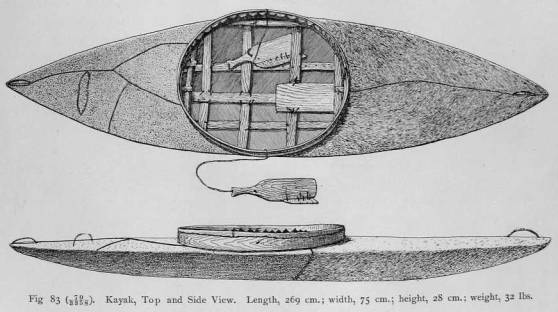
kayak is made as follows: A strip of wood curved
upward somewhat both fore
and
aft serves as the "keel." To both ends of the keel the ends of curved poles,
which serve as rails, are tied with thongs. As the keel is curved in
a
vertical plane, with its convex side downward, while both rails are in a
horizontal
plane, the rails lie on a level with the keel only at their points
of
junction, while at all
other points the rails lie higher than the keel.
For
1 See Chapter XIII.
2 See Bogoras, The Chukchee, Vol. VII
of this series, p. 126.
540
JOCHELSON, THE KORYAK.
this
reason the ribs
which join keel
and rails slant
upward. Thus
the cross-
section
of the bottom of the kayak has
the form
of an obtuse
angle. Thin
boards fastened
with thongs
to the inner sides of the ribs, and running the
full
length of the
kayak, between
the rails
and the
keel, give additional
strength.
The deck
is formed
by cross-bars
running from
one rail to the
other.
The manhole is near the middle of the deck, which
is also strength-
ened
by longitudinal
strips. The
manhole is formed by an oval hoop.
A
broad board lying
at the
bottom of
the boat
under the
rear end
of the
manhole serves as a seat,
which is usually covered with a piece of sealskin.
Like the skin
boat, the kayak is
covered with thong-seal skins. Ordinarily
two skins, the hair of which is not
always removed, are sufficient.
After the
kayak has been
covered with skin, the manhole is placed in position.
The
cover is so cut
at the
manhole as to leave enough material
to turn in the
edges, which are sewed around the hoop
by means of thongs.
The
kayak is very light, so that it can easily be lifted with one hand.
The
weight of one is 32 pounds. Its length is 269 cm. and its maximum
width
(i. e., the diameter of the manhole) is 75
cm. Its height
is 28 cm.
Near the prow and the stern of the kayak, skin
handles are sewed for
pulling
it out of the water, either upon shore or upon floating ice, or for
carrying
it across promontories. In certain settlements only a double-bladed
oar,
like that of the Eskimo, is used with these kayaks. It is held with both hands, in the middle, and the two terminal blades are used alternately. In
Itkana
and Paren two paddles with short handles are used, the blades of
which
have on one side pieces of bone of whale sewed on, which look like
fins.
These small oars are 41 cm. in length. They are tied to the rim of
the
manhole with a thong one metre in length, so that they can be dropped
into
the water or placed within the kayak while casting the harpoon or while
shooting.
With these short paddles they row alternately with right and. left
hand,
bringing their hands down almost to the level of the water.
Sitting
in the manhole, the hunter can stretch his feet under the deck
of
the kayak. In the kayak he places the harpoon-heads, the throwing-board,
the
bag with the harpoon-line, and his arrows. In the hold of the kayak are
kept
the harpoon-shaft, spears, and gun. When making ready for an attack
on
sea-animals, the hunter places the harpoon on deck, first thrusting the end
of
the shaft into a skin loop which is sewed to the deck of the kayak near
the
prow.
The
progress of the kayak in calm weather is extremely fast; but its
use
is not without danger, as it is easily upset by wind or waves, and it is
necessary
to balance it carefully while paddling. In stormy weather the
Koryak
do not venture upon the sea in kayaks.
Dug-Outs.
—
In the settlement of Kamenskoye and in northern Kam-
chatka
dug-out canoes
are also
used, like those employed by
the Yukaghir
541
JOCHELSON,
THE KORYAK.
and Kamchadal, who have no skin boats. These
canoes are called struzhok
(стружокъ) by the
Russians, and yañca'atwat or yañiya'atwat by the Koryak.
They
are hollowed out of poplar or aspen trunks by means of an adze, and
are
so well made that they are not heavier than skin canoes.1 The dug-out
is
propelled with a double-bladed paddle, while in shallow and rapid rivers
it
is punted with two short poles. The dug-out is rather a river-boat; but
the
inhabitants of Kamenskoye, and the maritime Koryak of northern Kam-
chatka,
go out in them on the
bays to hunt seals, like the
Kamchadal.
Another
kind of dug-out, but for river use exclusively, is that called bat
(батъ)
by the Russians, or elle'ut by the Koryak. It is about twelve metres long,
or longer, narrow, and heavy, roughly hewn, and hollowed like a trough.
It
is in use also among the Kamchadal, but is not met with among the
Yukaghir.
This boat is used mainly for crossing rivers and for trips up and
down
rivers. It is built for two persons on the prow and one at the stern,
who
use long poles for punting, When fish are caught on the bank opposite
a
village, they are taken across in such boats. For ferrying cargoes and men
across
the river or floating them down the river, a catamaran is made of two
such
boats, which are joined by means of a bridge (Fig. 84).
A double boat

of this kind is very convenient for freighting,
and is quite safe. Whenever
the Koryak fish in the river, above their village, they descend with their
families
and their catch in such crafts when
the fishing is over.
Hunting
of Sea-Mammals. — Among the palaeasiatic tribes, the seden-tary
Yukaghir alone live by fishing exclusively. The Kamchadal engage in fishing
principally, and hunt very little for sea-mammals. Among the Maritime
Koryak,
as among the Gilyak, the hunting of sea-mammals is of great import-
ance,
although at present in most of the Koryak settlements fish is a more
important
staple food than sea-mammals. In former times the hunt for sea-
mammals
was more important among the Koryak than it is at present. Like
the
Eskimo, the Maritime Chukchee continue to hunt principally sea-mammals,
and
fishing plays a secondary role in their household economy.
Seal-Hunting.
—
Seal is the mammal most extensively hunted, especially
1 Further details concerning dug-out
canoes will be found in the
monograph on the Yukaghir.
542
JOCHELSON, THE KORYAK.
in
Penshina Bay.
The following
species are
found in
Koryak waters:
(I)
ground-seal,
or bearded
seal (Erignatus barbatus;
Koryak, mémel;
Russian, nerpa
or lakhtak), the largest of seals, measuring from 2 metres to 2.6
metres in
length; (2)
spotted seal
or Okhotsk
seal (Phoca
Ochotensis; Koryak,
keli'lin;
Russian, larga);
(3) ringed-seal (Phoca hispida;
Koryak, wi'twit; Russian,
akipa), the
smallest of
seals; and
(4) ribbon-seal
(Hìstriophoca fasciata; Koryak,
esgi'es; Russian,
krylata). The
last-named seal
inhabits
only
Bering Sea;
but an
old man
from the
settlement Kuel told me that
once
he had caught a ribbon-seal which had incidentally entered Penshina Bay.
Ground-seal
and ringed-seal
are hunted
the greater
part of
the year,
except
during the
winter months.
When the
coast-ice breaks up, early
in
June,
and the rivers carry masses of ice into the sea, thong-seals and ringed- seals
are fond of lying on ice-floes, on which they are killed from skin boats and
kayaks. When
the river-banks are clear of
ice, the thong-seals like togo
ashore in bays and river-mouths and bask in the sunshine, or they lie on the
banks after
high tide.
But the principal
hunting-season for thong and
ringed seals is in autumn, — in September
and in the beginning of October.
Then the seals
enter the
river-estuaries, evidently
in the wake of the
fish
which ascend the
rivers to
winter there.
In autumn,
when the
coast-ice
begins to form
in the gulfs, thong and ringed seals again
enjoy floating on
ice torn away from the coast by the
tide or the wind.
The spotted seal appears early in June, soon after
the rivers are clear
of
ice, near the shores, and enters the estuaries, ascending in small numbers with
the flood-tide, and returning with the ebb-tide; but with the beginning of
the dog-salmon run, after the 14 th of July, the spotted seal, at flood-tide,
follows
the salmon into the rivers in shoals, in pursuit of the fish, which, in
their
endeavors to escape them, jump out of the water. Here and there the
seals are seen thrusting their heads out of the water, quite often holding a
fish in the mouth. In the month of June, when the run of the dog-salmon
begins,
I made a boat journey from the Gishiga River to the Nayakhan
River,
and saw all the rocks in this part of Gishiga Bay covered with spotted
seals
basking in the sun. We approached in our boat quite close to these
little
islands. Though the sea was perfectly calm, the incessant deafening
cries
of seabirds, particularly of the numerous varieties of gulls, drowned the noise
of the oars, and the seals noticed us only when we wereat a distance
of some thirty metres from them. As soon as they saw us, however, in an
instant
they rolled, grunting, off the rocks into the sea. In autumn the
spotted
seal leaves the coast. The main hunting-season thus coincides with
the
run of the dog-salmon.
In
winter, beginning with the middle of October, the hunting of seals
ceases.
The Maritime Koryak of Penshina Bay and Bering Sea do not resort to
the method practised by the Eskimo, Chukchee, and also by those Gilyak
543
JOCHELSON,
THE KORYAK.
who
live between
the mouth
of the
Amur and
Saghalin, of watching
for
seals
on the ice near the breathing-holes,
or of placing nets near these holes
he
sea does
not freeze over in
winter to any
extent, and the
narrow strip
of
coast ice
is often
torn away by the
wind. The
violent winds of winter
and the floating ice
make trips in
boats in winter dangerous or
impossible.
For
this reason
there is no
seal-hunting in winter either in
the open sea or on
the ice. It
is only by chance that every now and then a thong or ringed
seal
is killed
that goes
astray on
the coast ice
or crosses over an isthmus
between
two bays.
In Gishiga
Bay, where
many coves
freeze over
to a
much
greater extent than the
open coasts of
Penshina Bay, seal-hunting in
winter
at breathing-holes
would probably
be possible.
In excavating
old
underground
houses of the Maritime Koryak south of Gishiga I found, amono-
other
fragments of
bone implements, a round
piece of antler
of a fawn. According
to my
Russianized Koryak
companions, it might have served as an
ice-scratcher,
such as
are employed
by the
Chukchee and
Eskimo in seal-
hunting
in winter.1 At
the present time, with the exception of the Russianized
oryak
of the
settlement Nayakhan,
there are
no Koryak villages on
the
coast
of Gishiga Bay;
while the Russians and the Russianized Koryak hunt
for sea-mammals only incidentally, even
in summer.
At present, guns, nets, and harpoons are employed in
hunting thong-seal. Though
guns, as will be seen later, are nowadays common enough among
the
Koryak, they are used but little in seal-hunting. In deep water a seal, if
it
is not very fat, sinks immediately when killed by a bullet; if only wounded, it
escapes. In shallow water, when hunted with the gun, it must be killed
on
the spot, else the wounded seal will succeed in getting away to the sea. Not
infrequently even a seal killed outright is carried out to sea by the current
of
the river or by the tide, and cannot be found after the water has receded.When
detained by a gale in Atykino Bay2 for five days, we hit spotted seals
many a time with our Winchester and Berdan rifles, but only two of
them
were found at low water. The gun is of service only when the seal
is
ashore and far away from water.
In
summer and autumn, when seals enter the river-mouths and bays,
they
are hunted with nets. In autumn, seal-nets are set up mainly to catch thong-seals.
The net is netted of thongs made of the hide of thong-seals.
Fig.
85, c shows three meshes of such a net and the method of making the
knots.
The length of the side of a mesh is 23 cm.; the length of the whole net,
13
metres; its height, 14 meshes. These nets are placed in riverestuaries
or
on the beach. They are set at low tide by driving into the ground a ow
of stakes (Fig. 85, b), to which the nets are tied. The floats
(Fig. 85,a,
1
See Bogoras, The Chukchee,
Vol. VII of this series, Fig. 36, b, c, p. 199.
2
Atykino
Bay lies midway between the mouths of Gishiga and Nayakhan Rivers (See Plate
XXIX. Fig. 2).
69 -JESUP NORTH PACIFIC
EXPED., VOL.
VI, PART
2.
544
JOCHELSON, THE
KORYAK.
are made of wood. Thong-seals become entangled in
the nets when retur-ning
to the sea at ebb-tide. The hunters go to the nets before low water,and
with bone
mallets or
clubs hit
head and
nose of the
seals that are entangled
in the
meshes.
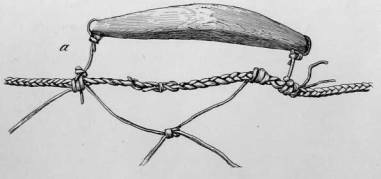
|
Fig.
86 represents
a mallet
used
for stunning
seals.
It is made
of
bone of whale,
and
the handle
is
of wood. Its
length
is 52 cm.
This
mallet is
also
used for killing
seals that have fallen asleep on the shore. |
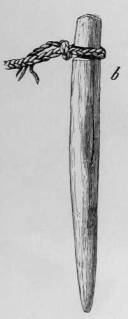
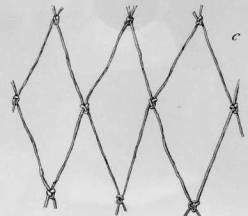
|
Up
to the present the harpoon has remained the
principal
weapon for hunting seals. Before learning the
use
of iron, the Koryak used to make harpoon- heads
(Koryak,
yiyi') for seals of bone or ivory.
Fig. 32, a-c, given by Mr.
Bogoras,1
repre-
sent types of har-
poons
similar to those
of the Es-kimo.
Closely re- lated to these is
the type of Ko-
ryak harpoon shown in Fig. 87,
c, and
in Fig. 92. The princi-ple of both of
these specimens
is the same as
that
of the Es-
Fig.
85. Details of Seal- Net. Size of mesh, 47 cm. a, Swimmer;
b,
Stake; c. Part of net. |
kimo harpoon-head with blade parallel to the
barbs. The back of the large
harpoon-head
is slightly keeled, and the barb is strongly curved and provided with
a notch. An ornamented specimen of this kind is shown in Fig. 191,
c.
It
is a characteristic trait of these specimens that the loop by which the harpoon-
1 Bogoras,
The Chukchee, Vol. VII of this series, p. 116.
545
JOCHELSON,
THE KORYAK
point is attached to the line is tied firmly to
the foreshaft. In all specimens
the
barb of the harpoon-point is held to the foreshaft by a loop which
passes
over the harpoon-head and over the thong loop by means of which the harpoon-head
is attached to the harpoon-line.
The latter loop is also attached to
| the foreshaft, which has a
perforation
for this pur-
pose
near its lower end.
When
the harpoon strikes
the
animal, the small loop
which
holds the barb to
the
foreshaft slipps off and the
toggle-head comes off;
without,
however, being |
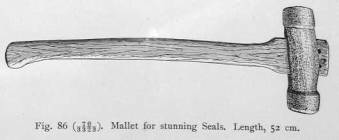
|
disengaged from the foreshaft, to which it is held by
the small loop which
passes
through the perforation near the base. Two of the small harpoons
here
described have a screw cut into the base, evidently to give to the point
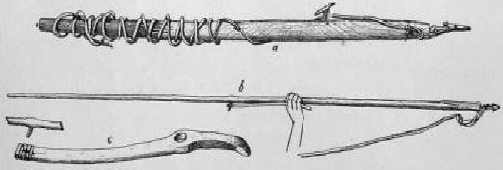
Fig.
87. Harpoon- Heads, a(70/3598), Harbed bone harpoon length of point, 16.5 cm.);
b ( 70/3281), Small barbed bone point (length of point, 5.8 cm.); c (70/3750),
Bone harpoon with iron blade and foreshaft (length of point, including
foreshaft, 12 cm.).
a better hold in the end of the harpoon. The occurrence
of the screw in
this
position is interesting when compared to the screw devices used by the
Eskimo
in similar positions.1
The
bone harpoon shown in Fig. 87, a, is evidently related to this type,
from
which it differs in not having a separate harpoon-head and foreshaft. It is evident, however, that the perforation at the base, through which the
line
loop passes, corresponds to the small perforation in the type of harpoon
described
before. The modern iron harpoon shown in Fig. 88, c, is closely related
to the bone harpoon just described, from which it differs only in the
arrangement
of its barbs. To the same type belong the iron harpoons figured
by ogoras.2
1
 See
Globus, Vol. 79, p. 8; Bulletin American Museum of Natural History, Vol. XV, p.
397.
See
Globus, Vol. 79, p. 8; Bulletin American Museum of Natural History, Vol. XV, p.
397.
2
Bogoras,
The Chukchee, Vol. VII of this series, Fig. 32, f, g, p.
116.
546
JOCHELSON, THE KORYAK.
Related
to this type are also the round barbed points shown in Fig. 87, b,
and
the one shown by Bogoras,1 the attachment of which is the same as
that
of the preceding specimens, while the barbs are arranged symmetrically
all
around the round point. The model shown in Fig. 88, a, is an imitation
of
a harpoon that has been in use for some time among American whalers,
and
which is characterized by its movable hinged joint.
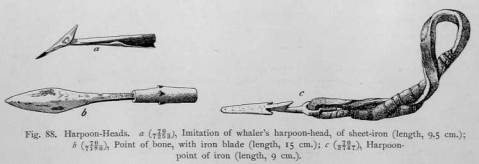
The
use of the remaining specimens shown in Figs. 88 and 89 is not
quite
certain. Fig. 88, b, represents a head that has probably been used with
an
arrow or a lance. The base of the bone part is hollow for a distance of a
little over one centimetre, and would fit the end of a wooden shaft. The four
barbs on the bone end have their sharp points turned forward, and
therefore
do not hold the head in the wound, but would only tend to tear the
sides of the wound. The two specimens shown in Fig. 89 also seem to
be
heads of arrows or lances.

At
present bone harpoon-heads are not infrequently made use of, but
most
heads are of iron or consist of two pieces, — an iron blade inserted into
a bone point.
The
harpoon-line, which is about 18 metres long, is made of the hide
of
a thong-seal. It is coiled up and kept in a small round basket woven of grass
or nettle-thread. The free end of the line terminates in a loop. Before
urling
the harpoon, the line is taken out of the basket, and the loop is put
on the hunter's left hand ; or it is tied to the stern of the skin boat, if the
harpoon
is cast from the boat.
1 The
Chukchee, Vol VII of this series,
Fig. 32, i, p. 116.
547
JOCHELSON,
THE KORYAK.
There are two kinds
of harpoon-shafts, — the simple
shaft (Fig. 90, a);
and
a longer one,
used with
a throwing-board (Fig. 90,
b, c).
It is curious that
the Chukchee
employ a
throwing-board only
for casting the bird-dart.1
On the
other hand,
the Eskimo of Baffin
Land and of Alaska make use of
the
throwing-board both for the
seal-harpoon- and for the bird-dart
The
method of attaching the foreshaft and the harpoon-head to the
harpoon-shaft
is shown in Fig. 90, a. It will be noticed that the line passes
through
a loop which is inserted in the shaft near its point. The loop con
sists
of a
small strap,
and is closed
by a button. It will thus be seen that

the
harpoon-point, after the
animal has
been hit,
remains attached
to the
short
shaft, which acts as a drag and float.
At its
tip, the
shaft of the long harpoon has a head made of bone of
whale,
with a hollow in its upper part, into which the lower end of the harpoon-
head
is inserted.
The shaft
tapers down
to its
butt-end. The
throwing-
board
has two holes. Into
one of these, in the handle part, the index-finger
of
the right hand is
inserted; while into the other, in the back, is inserted
a bone peg, which is driven into
the harpoon- shaft a little behind the middle (Fig.
90, c). The
thumb grasps the shaft on the left side, while the other three
fingers
support it lightly on the right.
The bone peg is curved back somewhat
toward
the butt-end of the shaft to prevent it from slipping off the throwing- board
by the
weight of
the forward
part of
the shaft and
head. It
is
specially
liable to do so, owing to the
inclination of the harpoon when hurled
from the skin boat.
When the harpoon is hurled forward with great force,
by
means of
the impetus given
by the swing of the throwing-board,
which acts
against the
peg, the hand
quickly lets go the shaft and at once makes a
backward movement. The
peg is set free, the shaft with its
head darts on in
the desired direction, and the
throwing-board remains in the hunter's hand.
After
the harpoon-head has
been driven
into the animal's body, the shaft is
set
free by the shock,
and falls into the water, from which the hunters take
it
back after the animal has
been killed. The
seal immediately dives, drag-
1 Compare Bogoras, The Chukchee, Vol.
VII of the series, pp. 145, 146;
Boas, Central Eskimo, p. 496.
2 See Boas, Eskimo of Baffin Land, p. 80; Nelson, The Eskimo about Bering
Strait. p. 136.
548
JOCHELSON, THE KORYAK.
ging the
line along, but the necessity of breathing compels it to emerge.
Then
the hunters endeavor to harpoon it again; but if the seal has been killed
outright or severely wounded, it is dragged to the boat and lifted into
it
by means of hooks.
When ever
a hunter has caught a seal on shore, and has not succeeded
in
cutting off its retreat, he sends a harpoon after it without using a
throwing-board.
When hunting in kayaks, and in the pursuit of seals basking
on
ice-floes, both kinds of harpoons are employed, without the throwing-board, or
with it; but the former method is in much
more frequent use.
On floating ice, seals are hunted both at the
beginning of summer and
in
autumn, when the ice, freezing near the shores, is torn off and carried
out
to sea. The hunters go out in a skin boat. On noticing one or more
seals
on a floe, one or more hunters are lowered into kayaks, and endeavor to
approach the seal from under the wind, until within range of the harpoon.
During
this operation the hunters have bags made of the white skins of
fawns
over their heads and shoulders. If the seals notice the kayak, the
hunter
stops paddling and lets his white hood still farther down, so as to
look
like an ice-floe. As soon as the seals have become quiet, the hunter
continues
his approach. Grasping the harpoon with his right hand, ready
for action, he tries at the same time to take hold of the floe, and to pull
himself
toward it with his left hand by means of a bone hook attached to a long pole (Fig. 91).
In case the seal is asleep, the hunter may go up to the

ice-floe in his skin boat, and even climb up from
the kayak. In the same
manner
rocks and islands on which seals
lie are approached in kayaks.
Hunters
in kayaks cut off the retreat to the sea, of seals which have remained
in shallow bays and river-estuaries during ebb-tide.
Winter
supplies are principally obtained from the hunt in autumn. The
seals
caught from early until late in summer, and principally the spotted seals
killed during the dog-salmon run, serve for immediate use only. It is
impossible
to lay by supplies at this season, because the meat decomposes
rapidly.
Besides, the seals are not very fat in summer.
During
the fishing-season the hunters pay little attention to seal-hunting.
They
are too intent upon catching fish and preparing it for the winter
supply.
Besides, there is
plenty of
food in
summer. It
may happen that
549
JOCHELSON, THE
KORYAK.
from a
lean seal
only the
skin is taken,
while the carcass
is cast into the sea. In many cases
the spotted seal is hunted
in summer for its skin only The whole winter supply
of seals
is obtained
in autumn by means of net and harpoon. At
this season
the temperature
is so low that in the night or
even by
day, the
dead seals
freeze and
can be left in their skins. In autumn
the seals
are very
fat, and
when shot
with a gun do not sink so
easily.
The hunters
usually make two
autumn expeditions
out to
sea for
hunting
seal (mainly
thong-seal, in
part ringed-seal,
and very
few spotted
seals),
each expedition
lasting several
days. Each
boat is
accompanied by several
kayaks, which are
either taken aboard or
follow on independently
In
Kamenskoye and Itkana I collected some information concerning the
numbers
of seals killed for winter supply by the hunters in the autumn of
1900.
The hunters keep no account of the number of seals killed and eaten
in
summer. In Kamenskoye the inventory made by me, of the autumn hunt
of
nineteen families, gave a total of 272 thong-seals, or an average of 14.3
to
a family; the minimum catch of a family being 3, the maximum, 27.
They
had hunted ringed-seals as well, but kept no account of them. They
were
few in number, and part of them were eaten during the hunt. In
general,
during the autumn hunt attention is
paid to the large seals only.
In Itkana I recorded the results of the autumn
hunt of seals for the
winter
supply of seventeen families. There were, in all, 292 thong-seals and
89 ringed-seals, with an average of 17.2 thong-seals and 5.2
ringed-seals to a
family. I also learned that 112 thong-seals were caught by means of nets, and
180 were killed with harpoons. It is clear from this that the inhabitants of
Itkana were more successful than those of Kamenskoye. This is explained
in
part by the fact that very little salmon is caught at Itkana, which is
situated
on a bay with a small river in which the dog-salmon does not run,
and
therefore they have to content themselves mainly with catching such
small
fish as the salveline, tom-cod,
smelt, and uyo'k (Salmo socialis).
The
inhabitants of Kuel and Paren, who obtain large supplies of dog-salmon
on the Paren River, are much less occupied with seahunting than
those
of Itkana, and also less than those of Kamenskoye, who obtain dog- salmon in great quantities. The inhabitants of these settlements live
prin-
cipally
on fish.
Whale
and Walrus Hunting. —
In former times whaling played avery
important part both in Bering Sea and in the Sea of Okhotsk. To judge
from the stories told by the Koryak, Penshina Bay used to be rich in
whales,
which were hunted frequently. This is sufficiently proved by the
pre-eminence
of the whale festival over other festivals. It is known from
ancient
records that American whalers visited Penshina Bay as early as the
beginning
of the last century. Old Koryak still relate how they themselves
used to go whaling, but this
industry came to an end many years ago.
The
550
JOCHELSON, THE
KORYAK.
Koryak
say that
until lately three
American whalers used to go to Penshina Bay
every summer,
but in
the last
two or
three years
only one
went.
Evidently the whales
have left
for the open sea to escape
being hunted in
the bays. While entering Nayakhan Bay 1 in a boat, we saw a great number
of whales
blowing far away in
the mouth
of Gishiga Bay.
The Koryak
do not
venture to
go whaling
in their
skin boats
in the
open sea.
During their expeditions
they do
not go
far from
shore. In
calm weather
they
cross Penshina Bay
only at its narrow part, from
Ma'mec to Itkana or from Ma'mec to Kamenskoye.
If the Koryak
have obtained any
whales during
the last few years, they have either
been dead ones drifted ashore — whales wounded by whalers,
but not
caught by them, or those
that perished from
the
attacks of the
killer-whales — or whales killed
by the American whale-
men and
left to
them. In
the latter
case, the
whalers take
off the skin,
blubber,
and whalebone,
and, after informing the Koryak, throw
the rest of
the body
ashore, or
even tow
it to the
nearest settlement.
The Koryak speak
with gratitude of
these acts of the American whalers or at-ayim (i. e., "chiefs of the boats"); but probably the
rapacious pursuit of whales
by whalers
is
the principal
cause of their disappearance from the Koryak bays.
In the
summer of 1900
the Koryak
of Penshina Bay had two dead
whales. One
was cast
out by
the sea
near the
settlement Ma'mec, and
the other was taken
to the village Itkana
by an
American whaler, — the only one that
year in
Penshina Bay.
It goes
without saying
that whaling
by foreign
whalers
in Koryak
waters is
considered illegitimate by the
Russians, and
is possible only because of the
absence of a Russian cruiser.
Exactly
what species of whale the Koryak hunted is difficult to say.
The
whale which they honored with a festival is called by them yü'ñin. According
to their description, this is the largest of all whales, with a skin of
dark
color and with black whalebone. When killed, the whale does not sink,
owing
to its blubber. This is evidently the Greenland whale (Balcena
mysticetus L.). Another whale is called "diarrhoea-whale"
(poqlã'-yü'ñin). It is
small,
and has white whalebone. The Koryak never hunted it, but ate it when
washed
ashore by the sea. A third kind of whale is called lu'kula'n, and
is
met with in the ocean, but never enters the bays. Finally the Koryak
are
also familiar with the killer-whale (Orca gladiator Gill), which they call
"wedge-whale"
(wu'li-yü'ñin); but I did not observe that it is an object of cult,
as among the Gilyak, who consider it a beneficent spirit, that kills
large
whales for them. Krasheninnikoff says that the Kamchadal dread the
killer-whale
so much, that they not only do not kill it, but do not even
approach
it, for fear that it will upset the boat of the hunter. Whenever
they
saw a killer-whale approaching their boats, they sacrificed to it, praying
that
it might do them no harm.2
1 Compare p. 403.
2 See Krasheninnikoff, I, p. 426.
551
JOCHELSON,
THE KORYAK.
Several
skin boats
joined in
hunting the
whale. The
greatest chance
for
success was
during the
spawning-season of
small fish,
like the
uyo'k (Salmo
socialis) and other
species of
smelt, which
were pursued
by the
whales
into bays and rivers. Whales
were hunted exclusively with a harpoon with stone head.
Heads made of bone
were not in use. According
to the
Koryak,
the painful
wounds inflicted by bone heads did
not cause any par-
ticular
harm to the whale.
The rifle-bullets which the Koryak tried to use in
whale-hunting,
after they
had become
familiar with fire-arms,
would stick in the
layer of
blubber without
causing the
whale any
injury. Only
stone heads,
with their
numerous irregular facets and saw-like edges, cause
deadly lacerated wounds.
It is plain that the perfected
methods of hunting resorted to
by civilized
whalers were
unknown to
and beyond
the reach
of the
Koryak.
|
Fig.
92 represents a stone
harpoon-head for whaling (yiyi'). It consists
of a flint blade (a), the lower part of
which is inserted in
the
head (b), made of the antler of a wild reindeer. The blade
is fastened to the head by means of gum of the larch- tree.
Attached to the head is a thong (c) of walrus-hide, forming a loop below for tying on the harpoon-line. As in
the
harpoons for seal-hunting, the loop passes through a hole of
the harpoon-head. The wooden foreshaft of the harpoon
(d)
is
inserted in the hole at the bottom of the head, while
its
butt-end is inserted in the point of the harpoon-shaft,
which
is made of bone of whale. Into this the wooden end
of
the harpoon-head is inserted. These parts are joined by a lashing of whalebone, as shown in e. The length of the
whole
harpoon-head here figured is 113
cm.
When
going out on a hunting-expedition, each skin boat
carries
one or two harpoon-shafts, one or two harpoon-lines
coiled
up in grass bags, about half a dozen harpoon-heads
placed
point upwards in a tall wooden pail, from four to six
stone
spears, seal-skin wallets containing a change of clothes for
the hunter, and a tripod
with a sail.
The
most skilful hunter is stationed in the bow of the
boat.
When near to the whale, he hurls the harpoon with
all
his might.
Immediately the
whale dives, carrying with
|

|
it the harpoon-line and the boat to which the end of
the line is fastened.
When
the whale comes up again to blow, — sometimes after a long time,
the
hunters in the boats that happen to be nearest endeavor to drive another
harpoon
into it. When it is tired and worn out from the wounds received
in
this way, the boats advance nearer and despatch the whale with stone
spears
(a'uta-qa'mvin) such as
represented in Fig.
93. A
separate stone
70—JESUP NORTH PACIFIC
EXPED., VOL.
VI, PART
2.
552
JOCHELSON, THE KORYAK.
head of such a spear (a'ut) is shown in Fig. 136,
a. It is 15 cm. in length.
The
lower narrow part of the a'ut is fitted into a hollow at the thicker end
of the wooden spear-shaft, which is wound with a thong. When the whale
is
dead, its carcass, which is studded with harpoons and spears, is taken in
tow
by all the boats that have participated in the hunt, as shown in
Fig.
247 and is hauled to
the village.

Krasheninnikoff
relates1 that in his time the people of Alutor caught
whales
in the bays in enormous nets made of smoke-dried walrus-hide thongs
as
stout as a man's arm.2
White whales (Delphinapterus leucas) are
hunted in the same way as thong-seals. The white whale (Russian belukha Koryak,
yiyi'ñin), too, comes into the bays and river-estuaries with the flood-tide in pursuit of
fish, and goes back to the open sea with the ebb-tide. The full-grown white
whale measures four metres and upward in length. Not infrequently it runs
into
the nets set for catching thong-seals. Both sealing-harpoons with iron
heads
and whaling-harpoons with stone heads are used in hunting white
whales.
When the white whale is worn out from wounds, it is despatched with
a stone spear in the manner described above. If the white whale
does
not hurry to return to sea with the ebb-tide, while the water is still
high,
the hunters block the river-mouth in their kayaks, and drive them back
into
the river by means of shouts and by striking the water with their oars
until
the estuary becomes shallow and the white whale remains almost high and
dry. It is then easily killed with rifles and spears. In this way the
Koryak
sometimes shut whole shoals of white whales within the river-mouths, as
was the case in the summer of 1899, when the Koryakhemmed in sixteen
white whales in the estuary of the river Ovekova. Still the number of these
animals caught is insignificant in comparison with the enormous quantities
found
in the Koryak waters. Thus during the summer of 1900 the inhabit-ants
of Kamenskoye caught nine white whales; those of Itkana, six; and those
of Kuel, only two. Plate XXVIII, Fig. 2, shows how the inhabitants of Kuel
haul a white whale caught in seal-nets on dog-sleds over the coast-ice
to
the settlement. This
photograph was taken in the
beginning of October.3
1
See Krasheninnikoff, I, p.
421.
2
In
looking over the annual reports of the commander of the district, in the
Gishiga archives I found some
data as to the number of whales killed by the Koryak in certain years,
Judging by other statistical data contained
in these reports, these numbers are doubtless also below the actual.
A catch of two whales is recorded for 1848 in
Paren, and
of two whales in
Kamenskoye; for 1856,
three whales
in Kamenskoye; for
1886, six whales in the
whole of Penshina Bay.
3 See
description of festival, Part I, pp. 69-77.
553
JOCHELSON,
THE KORYAK.
I will remark here that seals are hauled from the
shore to the village over
the ground or ice by means of a thong, which is usually passed through a slit
running from under the lower jaw through the mouth. I did not see among the Maritime Koryak of Penshina Bay any small sleds such as are
used
by the Chukchee and Eskimo
for conveying home seals.1
In
the Bays of the Sea of Okhotsk there are no walruses and sea-lions
nor
any ribbon-seals (Histriophoca fasciata). Old people in the village of
Itkana
told me that they knew of one case of a walrus being caught in
Penshina
Bay. How reliable this information is I do not know. The walrus
in
Bering Sea has decreased very much in numbers owing to its incessant unlawful
pursuit. They are hunted by the Koryak in the same way as
seals,
— mainly with harpoons. In former times the Karagha estuary and
the
bays of Karagha Island were favorite localities for walrusing.
Hunting of Land-Game. —
The wild reindeer and the mountain-sheep
or
Kamchatka big-horn (Ovis nivicola Eschholtz) are the only wild land-
animals
killed by the Koryak for food. The elk and the musk-deer, which
are
met with on the southern coasts of the Sea of Okhotsk and west of the Stanovoy
Mountains, are unknown in the Koryak territory, at least nowadays. The
hunt of wild reindeer is unimportant; and there are few hunters
who
make a specialty of this pursuit, as is the case among the Yukaghir
and
Tungus. Besides, the wild reindeer in the Koryak territory are not numerous.
The domestic reindeer, for which the best pastures are selected, has
pushed the wild herds to the north or to the less favorable pastures of the
mountain-chains. They are found in small herds only, on mountain-tops in
summer, and in the tundras and river-valleys in winter. On the Palpal
Ridge
a wild reindeer is found which crosses the Anadyr River and lives in summer
on the coast of the Arctic Ocean. Small herds of the migratory
wild
reindeer reach the most southerly parts of the Koryak territory. The
Maritime Koryak rarely hunt the wild reindeer. It is pursued principally by
the
inhabitants of northern Kamchatka and of the Parapol Valley, and particu- larly
by the Koryak on the Palpal.2 Still the hunt is not carried on
regularly.
In
domestic life, as well as in trade, the wild reindeer is of slight importance
only.
Skins of wild reindeer are not exported from Gishiga; while among the
number of reindeer-skins exported from the Anadyr and the Kolyma
Rivers
the skins of wild reindeer occupy an important place,3 since on these
rivers
many are killed during their migrations to the north and back.
Like
the wild
goat, the mountain-sheep is
fond of rocky mountain-tops,
where
it feeds
on alpine
marshes. It
is especially numerous
in the Kam-
1
 See
Bogoras, The Chukchee, Vol. VII of this series, p. 107.
See
Bogoras, The Chukchee, Vol. VII of this series, p. 107.
2
In
regard to the methods of hunting wild reindeer compare Bogoras, The Chukchee,
Vol. VII of this series, pp. 132-136; Jochelson,
Sketch of the Hunting Pursuits and Peltry Trade in the Kolyma Country (St.
Peterburg,
1898), pp. 41-48.
3
See
Jochelson, Sketch of the Hunting Pursuits and Peltry Trade in the Kolyma Country,
p. 38.
554
JOCHELSON, THE KORYAK.
chatka
Mountains. It is
hunted in
the mountains
of northern Kamchatka,
the
Ma'mec Ridge,
the ranges
of the Alutorsk
region, farther to the north,
and
in the
mountains of the
western coast
of Penshina
Bay and
the
Taigonos Peninsula.
The meat and fat of the mountain-sheep
are considered
a very toothsome dish.
The hunt for the
animal takes place
principally in autumn,
when the
sheep take
on a
thick layer
of fat,
and their
skin is
covered with new
and strong wool.
The fur of the mountain-sheep is con- sidered warmer
than that of the
reindeer. Occasionally
the animal is killed
in
other seasons
also. Among
the Maritime Koryak of northern
Kamchatka
there are special
hunters who
go out into the mountains in autumn and in
the beginning of
winter to
hunt sheep.
Some of the
Taigonos Reindeer
Koryak hunt it
succesfully in winter.
During my
stay on the Topolovka
River, in the
latter part of April,
1901, two Koryak of the camp in which
I lived killed four mountain-sheep.
In Kamenskoye I saw a Maritime Koryak
from
the village
Ma'mec who
had killed twenty sheep during the winter of
1900-01. The
skin of the
sheep, like
that of the
wild reindeer,
is not
exported. In
olden times
the sheep
was hunted
with the
bow, but
now
it
is pursued
almost exclusively
with the
gun. Besides
its meat and skin,
the
sheep yields splendid horns
(from half to three-quarters of a metre long,
following the curvature), which are
used for the manufacture of various articles,
like spoons, ladles, and cups, and
also for carvings.
Hunting
of Fur-Bearing Animals. — I will
begin my description with
the
hunt of the bear,
for, like the wild reindeer and the sheep,
not only its
skin
is used,
but its
meat is eaten as well,
especially in autumn, when
the
bear
is fat.
The brown
bear (Ursus
beringianus Middendorf;
Koryak,
koi'ñin)
is abundant in Kamchatka, where the
rivers are rich in fish. In
the
oryak
territory bears
are also
quite numerous.
In 1899, 380
bear-skins were
exported to Vladivostok from Gishiga
and Alutorsk.1
In summer, bears
are
killed when they come down from the
mountains to the river-valleys and
the
seacoast to
hunt fish;
in autumn,
when feeding
on berries
or when visiting the storehouses
of the
Koryak to
steal the
fish stored
there for
winter
use; and in winter they are killed in their lairs. In the spring, when
the bear leaves
its lair,
it is killed only in
self-defence. The bear is then
lean,
and its skin useless; but an
encounter with it at this season is not safe
for
man. In summer
and autumn the bear rarely attacks man, usually taking
flight
on meeting
him. It
is said that in autumn,
when a bear happens to
surprise
women while picking
berries, it merely takes the
berries away from
them,
letting them
go unharmed. In
summer and autumn the Koryak
kill bears
mainly with
the gun;
in olden days they used the bow for this pur- pose. Not infrequently they
attack the bear with the spear.
In both cases,
1
See Chapter XIII, Trade.
555
JOCHELSON,
THE KORYAK.
hunting-dogs
are used,
which attack
the bear
from the
rear, make it turn
around
for self-defence,
and prevent
it from
rushing at the hunter,
who is
thus
enabled to take good
aim or to choose an
opportune moment for his attack.
There are
hunters among
the Maritime
Koryak who
train dogs
especially
for hunting.
These are
not used
in harness.
Many of the dogs
used
for
hauling sledges
are not
only of
no help in bear-hunting, but are
even
a hindrance, owing to their
cowardice, since they will hide
behind their
master.
In winter
the bear
is attacked
in its den
in the manner common
throughout
Siberia. The
opening of
the den
is blocked with logs, so that
the
animal, when awakened, cannot
get out. The roof
of the den is broken
through,
and the
bear is stabbed to death
with a spear or killed with a gun.
Snares
made of stout thongs are placed near
the storehouses. I did
not hear of
other bear-traps,
such as are employed in
other parts ofSiberia. I
have
described
before the festival in honor of the bear.1
Foxes,
particularly red foxes, are caught in great numbers, and their
skins
constitute the greatest part of the furs exported.2 Fox-hunting is carried
on
in various ways, — with dogs, which the hunter sets on the track; by
the
Reindeer Koryak with reindeer-sledges. It is overtaken, and killed with clubs.
Still another method is to drive the fox into its own den or into ahole,
from which it is either pulled out by means of a cleft stick, or smoked
out.
Traps are also employed. These are the self-acting bow, the dead-fall, and
the edge-trap with a spring of twisted sinew.3 Shooting foxes with
guns is
seldom successful. Quite recently foxes have been poisoned by means of
strychnine
pills, which are scattered about. This method is in use near
Russian
settlements.
Krasheninnikoff
asserts that all traps of the Kamchadal were introduced
by the Russians. He states that previous to the arrival of the Russians the
Kamchadal
did not care for fox-skins, but preferred dog-skins, and that when
they
wanted to kill foxes, they did so by means of clubs. Foxes were so common
that they would come to the troughs when the dogs were fed.4I believe that the same conditions prevailed among the Koryak. Even at
present
they
set fewer traps by far than the Yukaghir and the Russianized tribes of Siberia.
The Eskimo and Indians, too, employ varioustraps for the capture
of
animals;5 but the traps with sinew spring,6 found in
Alaska, are probably
of
Siberian origin. The Koryak have evidently adopted the self-acting bow
either
from the Russians or from
the Yakut and Tungus,
who use it widely.
In
the fur
trade the
red foxes
of the Koryak territory, on account of
their
gorgeous and soft
fur and its fiery-red color,
are considered among the
1 See Part I, p. 88.
2
See Chapter XIII, Trade.
3 See
Jochelson, Sketch
of the Hunting-Pursuits, etc., Figs. I, 2, 5, 7, 9, pp. 6, 7,
11, 15, 18; Bogoras, The
Chukchee, Vol. VII of this series, Figs. 48-50, pp. 138—140.
4
See Krasheninnikoff, I, p. 340.
5
See Mason, Traps of the American Indians.
6 Ibid., Fig. 5, p. 472; Nelson, Fig.
37, p. 122.
556
JOCHELSON, THE KORYAK.
very best. They are equal in value to those of
Kamchatka and the Anadyr.
Since the arrival of the Russians in this region, the number of foxes has
considerably
fallen off, and they are now nearly extinct. In the neigh- borhood
of the Russian villages they are not seen at all. Their number
varies
considerably from year to year. Their migration northward or south-
ward depends on
the presence
of mice or hares,
which foxes follow.
The
Arctic fox (Vulpes Lagopus) occurs in much smaller numbers than
the
red fox. It is a tundra animal par excellence, and is found more often
in
the treeless eastern part of the Koryak country than in the western
district.
Blue foxes are very rare: their number constitutes about one per cent
of that of the white foxes. The methods of hunting the polar fox are identical
with those used for the red fox.
The squirrel
(Sciurus vulgaris) is hardly
hunted at all. It is found in
small
numbers on the upper course of the Gishiga and Penshina and of their
tributaries,
but is absent in the treeless and maritime region. In Kamchatka
the
squirrel does not occur at all, even in the wooded localities of the cen- tral
ridge. A small number of squirrels are obtained in the Gishiga district
by
the Tungus, but by far the greater part of squirrel-skins which are exported
by way of Gishiga is obtained from nomadic Tungus in the Kolyma district
and partly in the Okhotsk district. In former times the Tungus
killed squirrels by means of the bow. They used blunt arrows made of bone,
so as not to spoil the skin. The hunters would aim at the head of
the
animal when it was sitting in a tree. The blunt arrow would only daze
it,
and it would fall to the ground, where it was picked up by the hunter.
If
still capable of running, the squirrel was caught by the hunting-dog.
Nowadays the place of the bow has been taken by the flint-lock gun with
thin
bore for bullets of the size of a pea, which
do not injure the
skin.
The
sable (Mustela zibellina, Linn.), the most valuable fur-animal of
Siberia,
was undoubtedly at one time more widespread than it is now. At present only a few dozen sable-skins are exported annually from
Gishiga.
These
are caught in the river-valleys of Penshina and Opuka, and partly in northern
Kamchatka. In southern Kamchatka the Kamchadal even now kill
nearly
two thousand sables annually. The highest value is placed on those
from
the valleys of the Olekma and the Vitim, tributaries of the Lena, and from
Nerchinsk in Transbaikalia. They possess a down which is entirely
dark
and of bluish tinge, and long, soft, glossy black hair. The finest sables
have
silver-tipped hair. The sable of Kamchatka is not inferior to that of Olekma
in thickness of down and softness of hair; but, since it has a russet color, the fur is of inferior quality, resembling marten-fur. The
Koryak sable
is
somewhat darker than that of Kamchatka. The sable is hunted with the gun, in the same way as the squirrel. It is a good climber, and
in time of
danger
takes to
treetops for
safety. The
flintlock gun
used for
hunting
557
JOCHELSON,
THE KORYAK.
sables is of larger caliber than the one used for
squirrels. Oftentimes the
Kamchadal shoot sables with shot. If the animal runs into a hole, the hunter sets
a nettle-thread net near the entrance, and drives it out either with the help
of a dog, which digs the hole open, or by means of smoke. In our Koryak
collection there is a sable-trap with sinew spring from the Opuka
River.
It is one-third the size of similar traps used for catching wolves. In Kamchatka
a dead-fall is set for sables. Sable-hunting is a most difficult pursuit, because the animal is very quick and cleverly escapes its pursuers
It
vanishes in the snow, and makes passages under it;
it conceals itself
under
stones, dry boughs, and roots of trees, and leaps from tree to tree
making
it difficult to take good aim at it.
The
gray wolf (Canis lupus Linn.) inhabits the tundra. It is hunted
mainly
by the Reindeer Koryak, who have to protect their herds against its
ravages.
Besides, wolf's fur is considered handsome, and is used for manu-
facturing
caps, mittens, collars, and trimmings of clothing and foot-wear. Part
ot the wolf-skins are exported. In 1899 one hundred and twenty were
taken out of the Gishiga district. The Koryak hunt for wolves in the same manner
as do the Chukchee.1
Only
a few skins of ermine (Putorius ermineus Linn.) are exported,
and
it seems probable that the Koryak do not hunt it much. It would also
seem that this animal is not common in the Koryak territory.2 Ermine
is
hunted
by the Russians and by the Maritime Koryak, who set near their
store-houses
traps based on the principle of the self-acting bow, in which the
animals
are strangled.3 The Koryak have undoubtedly borrowed this device
from
the Russians. In Siberia it is specially favored by the Yakut, who
employ
it for all small animals, and I
think it is a Yakut invention.
The
otter (Lutra vulgaris) and wolverene (Gulo borealis) are rarely
met
with, and are therefore merely casually hunted. Formerly the skins of
both
of these animals were used for trimming festive garments. That of the
wolverene
served for adorning the finest clothes among the Koryak as well
as
among the Kamchadal and Chukchee. Even now wolverene-skins obtained
by
local hunters are not exported from the extreme northeast of Siberia, but
they
are imported by merchants as one of the most attractive articles of
barter.
At present the Chukchee are the principal consumers of wolverene-
skins,
and the wolverenes killed by the Kamchadal are also exported by
merchants
to the Chukchee.
Bird-Hunting.
—
Birds of passage, like ducks, geese, and swans, were
formerly
shot with bow and arrows, but are
now shot with rifles. However,
1 Compare Bogoras, The Chukchee. Vol.
VII of this series, pp. 137, 139.
On the wolf festival see Part I, p. 89.
2
In 1899, 124 skins were exported via
Gishiga, while from the Kolyma district 6000 ermine-skins
were
exported via Yakutsk.
3 See Jochelson, Sketch of the
Hunting, etc., Fig. 8, a, b, p. 17;
Bogoras, The Chukchee, Vol. VII ot tnis
series, Fig. 52, p. 143.
558
JOCHELSON, THE
KORYAK.
the Koryak are rather poor shots, and do not care
to hunt birds. In spite
of the abundance of
birds in spring and autumn, during the season of their
migrations north and south, they kill very few,
and do not lay by any stores of bird-meat.
The birds are eaten fresh
only.
Sea-fowl
are caught by means of snares made of whalebone or sinew-thread.
Winter birds, like the ptarmigan, are caught with nooses made of
sinew-thread,
which are tied to a board that has been placed in the snow.
They
are also driven into nets made of nettle-thread and killed with sling-stones
that are hurled
with slings of seal-skin
(Fig. 94).
If
there happens to be a nesting-place of ducks or geese, or other birds
of
passage, not far from the
village, the Koryak drive them ashore
and kill

them with clubs during the moulting-season, which is
late in July or early
in
August. In the village Talovka, bird-darts (Fig. 95) were used for killing
moulting
birds. Within a few miles, up the Talovka River, lies the favorite
breeding-place
of the geese. In August the villagers go there in kayaks to hunt
them while moulting.
They use bird-darts exactly like those employed

by the Russianized tribes on the Anadyr and the
Kolyma. The Koryak,
however,
do not employ the throwing-board, but hurl the dart with the hand.
War. — At the present time the Koryak wage no war.
The weapons
which
were used in days of old for war and hunting alike, as bow, arrows, and
spear, have been preserved to a certain degree as hunting-weapons;
while
the weapons that were used in war only, have now either entirely disappeared
or are retained als keepsakes.
Weapons.
—
Previous to the introduction of iron, stone and bone, and
partly
also wood, were used as material for arrow-heads. We have seen before
that stone harpoon-heads are still in use; but stone arrow-heads (auta'-
ma'xem)
are now hard to find. I never saw a complete arrow with stone
head.
They were evidently superseded more quickly by iron-pointed arrows
than
were those made of bone. Stone arrow-heads may be found in exca-
vating
ancient dwellings, but they are also preserved by some of the people
as
keepsakes or
as amulets.
Three stone
arrow-heads are represented in
559
JOCHELSON,
THE KORYAK.
Fig. 13 5. They were inserted in the arrow-shaft,
to which they were tied
with
sinew-thread. Bone arrows made of bone of the whale, reindeer and walrus
and mammoth ivory have been preserved by many Koryak, but' they are
not often used in hunting. Bone of whale was employed principally for
bird-arrows.
The bone arrow-head was inserted in a split in the shaft or it was
fitted on like a head, or fitted
into a groove in the shaft.
Wooden arrows
were made of one piece.
Iron arrow-points were either
fastened
directly to the wooden shaft,
or were inserted into a bone
foreshaft.
I
have collected
about thirty different
types of arrows. The shape of most
of
them is the same as that of the Chukchee arrows described by Mr. Bogoras 1
Five
arrows of somewhat different shape are illustrated here
(Fig. 96). That
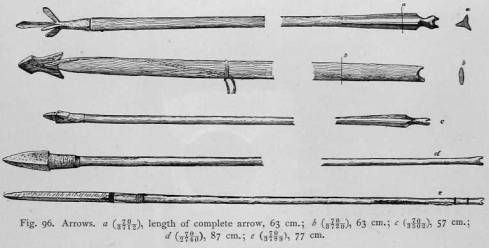
marked e represents a long arrow with a
three-edged head of mammoth-tusk.
Like
the lancet-shaped bone arrows, it was employed both in war and in
hunting
big land-game, such as reindeer and elk. These arrows are distin- guished
by their long head thin and long shaft, and by the feathering and were
used at long range. At d is shown a bird-arrow of bone of whale. The
one marked b represents an arrow for a self-acting bow for killing otters,
with a barbed detachable iron point. Like all arrows for self-acting
bows,
which strike at short range, this harpoon-arrow (uke'lwe-ma'xem) pos-
sesses a short, thick and unfeathered shaft. Its cross-section is oval. At c is
represented
an arrow with a head of antler; and at a, an arrow with an iron
head
resembling the head of a bird-dart. Both are used for shooting birds. They
are interesting on account of the imitation
of feathering in wood.2
1 See Bogoras, The Chukchee.
Vol. VII of this series, Fig. 74, p. I56.
2 Such arrows have been found
also among the Ainu and Gold (See Adler, Plate II, Figs. 1-4). I have
collected several iron arrows with pseudo-feathering of the type Fig. 96,
a, made entirely of one piece of
iron.
They are too heavy for shooting and were probably used as offerings.
(See Part I, pp. 43, 89).
71
- JESUP NORTH
PACIFIC EXPED.,
VOL. VI,
PART 2.
560
JOCHELSON, THE KORYAK.
At present the bow is used in hunting only when a rifle is not available,
which
is seldom
the case.
In certain
families old
bows and
arrows are preserved
with great
care, and
pass on
as heirlooms.
The bow
is still common in children's games.
Boys practise shooting,
and have contests in
which
they use as a target a
mitten suspended from a stick driven into the
snow.
Bow and arrows are burned on the funeral pyres of men; but in the
majority
of cases the funeral bow and
arrows are not genuine weapons, but
only
imitations. The
funeral bow
consists of a somewhat
bent stave, with
a grip in
the middle.
At the
ends a
thong is attached, which represents the
bowstring. The
arrows,1 too,
are imitations,
with pseudo-feathering at
the butt-end.
The Maritime Koryak were considered master bowyers.
Simple and
compound
bows were manufactured by them. The stave of the simple bow was
made of larch or alder; and its concave side was lined with a broad dorsal sinew of a
reindeer, which gave it additional elasticity. The stave of the
compound bow was made of two strips glued
together, — one of larch and one of birch, — which gave the bow
special strength. The concave side of
this bow, too, was usually lined with
sinew, and the convex back with birch-
bark. The grip of a good bow was bent
in (Plate XXIX, Fig. I) so that the
general form recalled to a certain
extent the ancient Greek bow with its two curves joined by a straight short
grip. The two horns of the bow, to
which the bowstring was fastened,
consisted usually of separate pieces, and
were glued to the ends of the bow-tree,
to which they were also tied by means of sinew.
Bowstrings
were made chiefly of thongs of thong-seal hide. One of the
bows
in our collection has a bowstring of sinew of the white whale. Krashe- ninnikoff
says 'that the Kamchadal used to make bowstrings of whale-sinew.
The
bow was held vertically, with the belly towards the archer; it
was
spanned with the index-finger of the right hand, the three other fingers
being
bent in; and the nock of the arrow was held from above with the thumb. The left hand held the grip of the bow, index-finger and thumb
lightly
supporting the arrow-shaft, while the other fingers clasped the bow.
Great strength and skill were required for spanning the bow, and constant
practice
was necessary. The bow of strong men was so stiff that a weak man
could not span it.
I
have mentioned before that long
and thin arrows were intended for long
range
shooting. These arrows were always feathered to steady their flight. On
the
other hand, the feathering suggests the idea of an analogy between the
flight
of the arrow and that of birds. The arrow-shafts were planed and
smoothed
with great care.
To remove all crookedness a bone instrument of
1 Compare
Part I, Fig. 49, a, b, p. 107.
Jesup
North Pacific Expedition, Vol. VI
Plate XXIX
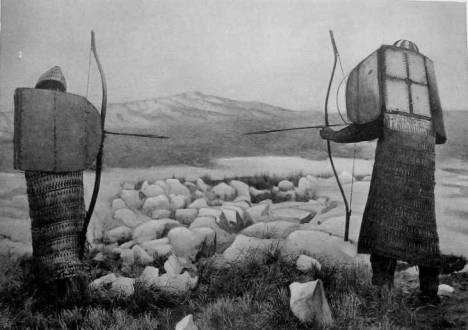
Fig.
i. Koryak Warriors
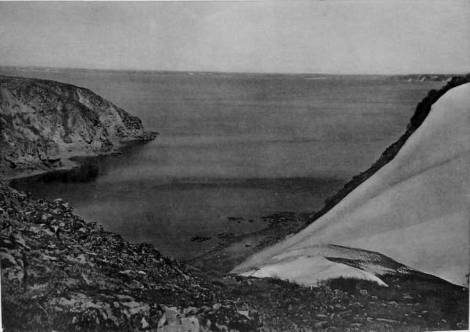
Fig. 2. Atykino Bay with
Remains of Fortifications.
The
Koryak.
56l
JOCHELSON,
THE KORYAK.
semicircular
cross-section (Fig. 97)
was employed,
which served as a plane
knives being inserted into the blade-holes.
|
Previous
to the
introduction of iron,
spears were
made of bone
and stone. The stone spear
is still
in use,
but only
for hunting
whales (see Fig. 93, p. 552). Traditions are still handed down
concerning
the bone spears which were used both in
war
and in hunting. Krasheninnikoff mentions the
threepronged
spears of the Koryak.1 Presumably
the
iron spear
superseded the
old bone
spear, at
|

Fig.
97. Bone Planer. Length, 7.5 cm. |
an early time. The spear played an important role in
hand-to-hand fights.
Tradition
relates how the heroes, wielding only a spear, overcame their enemies. In olden times there were also contests with spears. Iron spears2
are nowadays employed only in bear-hunting and in killing reindeer and dogs
for
sacrifice.3 Every herdsman owns an iron spear, which is tied to the
right
side
of the riding-sleigh, which is usually provided with bone rings for suspend-
ing
it.
Another weapon used in hand-to-hand fights was the
big knife (mainowal).
It
was about 50-60 cm. long, with a short handle of bone. It was carried
in
a sheath on the left side, like a short-sword, suspended from a shoulder-
strap.
It is not known what kind of weapon was supplanted by the iron
knife.
The Yukaghir, according to tradition, used long battle-knives made of elk-ribs.
The big knife is used at present chiefly by the Reindeer Koryak,
who
carry it on journeys and use it for chopping wood for the fire and for
cutting
frozen meat; but even in quite recent times this knife served as a
weapon.
Judging
from accounts of the customs of former times, the slung-shot
must
have been used in war. In consisted of a long thong of thong-seal
hide,
with a stone at its end. In one tradition which I recorded in Nayakhan,
in
which a battle between two heroes is described, it is related that the
warrior
from Nayakhan — who was known under the name of "Woman-
Snatcher,"
because he took by violence all the women who pleased him —
was
once surprised by a hostile hero when he had no bow and spear, but
only
a slung-shot, which he wore like a belt. While dodging his adver-
sary's
arrows, he hurled his slungshot at the latter with such force that the
line
encircled his body several times and cut
him in
twain.
The
Russians early introduced a wide-bore flintlock gun for hunting sea-mammals.4
Powder and lead are supplied by the government and are sold at
cost price. The
lead bullets are made by the
hunters themselves.
Some
Koryak own
Winchester rifles,
which are obtained either directly
1 Krasheninnikoff,
I, p. 51.
2 See
Fig. 143
3
See
Part I, Plate VII, Fig. 2, opposite p. 80; and Part I, Plate X, opposite p. 96.
4
For
description compare, Bogoras, The Chukchee, Vol. VII of this series, p.
159.
562
JOCHELSON,
THE KORYAK.
from American whalers or through barter from the
Chukchee. During the `last
few years many Koryak have acquired
Berdan rifles, with which the
Russian
Army was equipped until 1895. When the army was equipped with
magazine-rifles,
the government sold the old rifles at low prices. Thus the
Berdan rifle reached the Koryak. I took fifteen of these rifles along from
Vladivostok,
and exchanged them for articles for our collection, or gave them
away
in return for services.
Armor.
—
The Chukchee
and Koryak
coats of
mail collected by us
|

Fig.
98. Koryak Warrior |
have been described by Mr. Bogoras.1 I
merely wish
to
add that in my opinion the upper part of the armor
had
two wings. The absence of one wing from our
specimens
proves only that they are not complete. This
is confirmed not only by the presence of thong- holes on that side of the head-protector on which the
wing
is missing, and by the fact that in some pieces of armor
the right wing is missing, in others the left, but also
by the information gathered from men acquainted
with
the old customs of the tribe. At first some Koryak
explained
the absence of the left wing on suits of armor
by
the fact that they had belonged to lefthanded warriors,
and
that the wing was left off that the left hand might
be
free. This statement is mentioned by Mr. Bogoras ; 2
but subsequently, on further inquiry, some old men,
who
knew how armor had been worn, denied this, and
asserted
that the complete armor had two wings, protecting
the two arms. I was told, further, that the Reindeer
Koryak in the northern part of Palpal, where
I could not go owing to lack of time, still preserved
several
complete coats of mail which at present are worn
at
sacrifices on the occasion of the festival of reindeer-
races.3
A Reindeer Koryak of Palpal, whom I saw in
the
village of Kamenskoye, promised to bring me a
complete
suit of armor, but he did not keep his promise.
Even
the incomplete ones were obtained with great difficulty. For a long time the owners would not
agree
to
sell them. The
arms, which were passed through the |
loops inside the wings on the side of the
head-protector, held the armor in
place on the shoulders; while the fingers or hands were thrust through the small
loops at the edge of the wings when it was desired to cover the arm
entirely.
Fig. 98 shows
a Koryak clad
in armor,
with his
left arm free,
1 See Bogoras, The Chukchee, Vol. VII of the series, pp.
161-168. 2 Ibid.,
p. 165.
3 See
Part I, p. 88.
563
JOCHELSON,
THE KORYAK.
which, however, may be protected by the left wing,
like his right arm, by
putting
a wing-loop on his hand. How much strength, agility, and exercise must
have been required to fight in so heavy and uncomfortable a costume!
In
one myth,1 when Big-Raven offered his son Ememqut an armor for a battle
with the Chukchee, the son declined the offer and went to battle
armed
only with his spear.
Fig.
98 also shows how the helmet and arm-guards made of small iron
plates
were worn.2 The warriors wore a fur band under the helmet to
protect
the forehead against the hard iron. The lower part of the armor
which
consists of small iron plates tied together with thong, resembles a skirt.
It
was closed at the side by means of short straps.
Plate
XXIX, Fig. 1, represents two Koryak in armor, with bent bows.
The
plate is the reproduction of a photograph taken by me, except that the artist,
Mr. Rudolf Cronau, sketched in under my direction the missing wing of the armor.
Prior to their acquaintance with iron mail-coats, —
which I suppose were
introduced
by the Tungus,3 — the Koryak wore mail-coats of walrus-skin or
of small plates of bone joined by means of straps. Krasheninnikoff says that
"the
Koryak armor consisted of oblong bone pieces sewed together with thongs".4
Fortifications. — The maritime Koryak fortified their villages in
order
to
prevent sudden attacks by the enemy and to withstand a siege. Whenever
possible,
they built their villages on islands near the coast, to which they
resorted
to fish and hunt sea-mammals. They had temporary dwellings at
the
mouths of rivers. At the approach of a foe, they would take to their
boats
and disappear in the natural forts formed by the rocky islands. At
present
these islets are uninhabited, but it is said that on many of them
traces
of ancient dwellings may still be seen. To my regret, during the first
half of the summer of 1901, which I spent in the Russian settlement Kushka,
at the mouth of the Gishiga River, it was impossible to venture out in the
wooden
boats of the Russian settlers to the islands of which the Koryak
spoke
to me.5
Where
no islands were near the coast, the maritime Koryak fortified their
villages.
The islanders, too, fortified their temporary coast settlements. All
the
coast villages were built on hills with a steep descent to the sea. On the
land side the settlement was surrounded by an embankment, a stone wall,
or
a stockade.
When an
attack was expected,
sentinels were stationed on
1 See
Part I, p. 138.
2
Compare Bogoras, The Chukchee, pp. 167,
168.
3 See Chapter X.
4 Compare
Krasheninnikoff, II, p. 51.
6 During that summer I succeeded in
making two trips in wooden boats from the mouth of the Gishiga
River, — one to the Koryak at the mouth of the Ovekova River, a distance of
about fourteen miles; and the other
to the Koryak at the mouth of the Nayakhan River, a distance of a hundred miles.
The latter trip was considered
so dangerous that the Russian settlers advised me not to undertake it.
But luck favored us, the weather was fine,
and I covered the distance in two days, but on the return trip we were
detained in the uninhabited Bay of Atykino
(See Plate XXIX, Fig. 2) for
several days By stormy weather.
564
JOCHELSON,
THE KORYAK.
the
roofs of
houses or
storehouses; for,
in case
of a sudden attack by the
enemy on the hamlets of the sedentary Koryak,
the inhabitants of underground
houses found themselves,
as it
were, in
a trap.
For this reason,
at least
one guard
was always
kept in
the settlements
of warriors. In case of an attack,
the women
and old
people would launch
the skin boats, if the sea was open, so as
to be
ready to flee,
in case of defeat, with the
surviving
warriors. I was told that the inhabitants of the old
settlement near the mouth of the river Gishiga, having
lost a
battle with the Cossacks, took to their
skin boats, and succeeded in escaping
to the Yamsk Koryak. At
the mouth
of the river Nayakhan
I saw traces of a fortified
settlement. It was situated
on
a rooky
promontory, with cliffs
on three sides rising
abruptly from the
sea. On
the fourth
side there is a steep
descent to the river-valley.
This
slope had been protected with
a stone rampart. Piles
of stones which once
formed the wall are still visible.
Tradition relates that the Russians were led there by Tungus
who were
hostile to
the Koryak.
The latter stubbornly
defended the approach to the village.
It was
winter, and
they poured water on
the slope
to make
it slippery.
During one
night the Russians forged
sharp iron ice-creepers,
tied them
under the
soles of
their fur boots, and
stormed the fort.
Many of
them perished
from the arrows of the Koryak
and
from stones which they
rolled down; but as they were
many, their fire- arms gave
them the
victory in
the end.
Thereupon the
Koryak warriors
slew
all the
women and children in their
houses. Many of them committed
suicide, and only
a few
found safety in
flight by sliding down the cliffs to
he sea, and reaching Paren over the
ice. I found traces of a fortified settle-ment also in the Bay of Atykino (Plate
XXIX, Fig.
2).
At
sight of an enemy, the Reindeer Koryak drove their herds up the
mountains
and defended the approach. In the open tundra they would sur-round
the camp with a wall of sleighs placed upright and tied together with
thongs,
having first driven the reindeer into the corral. From this fortified
corral
the warriors would make sallies or go out to accept a challenge to
single-handed
fights with the champions of the invaders.






























